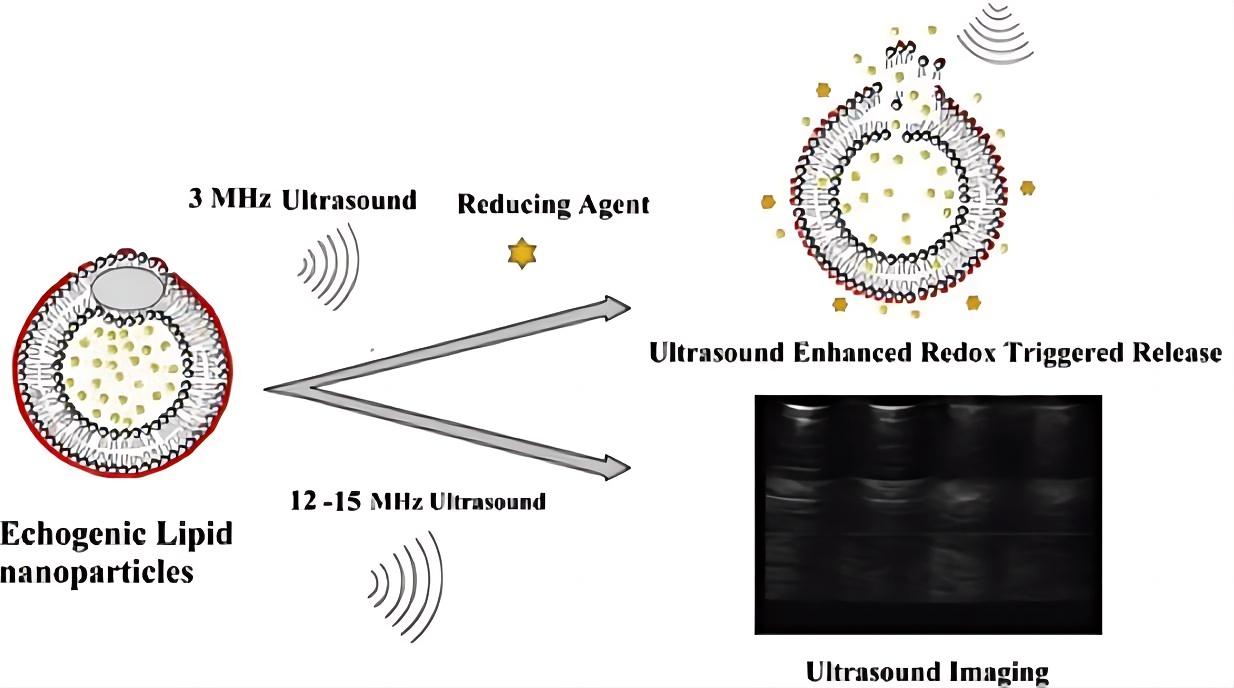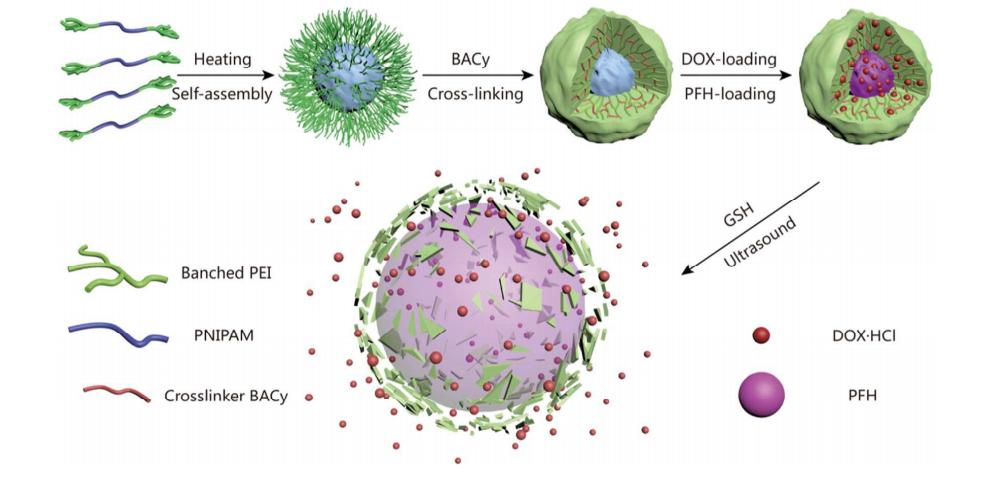Custom Redox-ultrasound Responsive Liposome Service
Inquiry
Redox-ultrasound responsive liposomes have recently attracted significant attention as an innovative stimulus-responsive delivery system. CD Formulation is dedicated to advancing liposome formulations by leveraging state-of-the-art technologies and specialized expertise to engineer high-performance liposomes that respond to both redox conditions and ultrasound.
Mechanism of Redox-ultrasound Responsive Liposomes
Sonodynamic therapy (SDT) has been proposed as an innovative approach for cancer treatment, utilizing low-intensity ultrasound to activate sonosensitizers. Echogenic liposomes, acoustically reflective lipid nanoparticles, have been engineered as responsive drug carriers. However, a single ultrasound trigger mechanism cannot ensure precise targeted therapy. Therefore, combining more prescribed mechanisms can improve targeting and therapeutic effects. The redox/ultrasound-responsive liposome delivery platform combines SDT and chemotherapy, not only suppressing tumor growth and metastasis, reducing the expression of transfer proteins, but also inducing an immune response by releasing tumor-associated antigens.
 Fig.1 Schematic representation of redox/ultrasound liposomes. (Nahire R, et al., 2013)
Fig.1 Schematic representation of redox/ultrasound liposomes. (Nahire R, et al., 2013)
Our Redox-ultrasound Responsive Liposome Customization Service
Study on the mechanism of redox and ultrasound triggering
Ultrasound-mediated cavitation generates sonoluminescence, activates sonosensitizers to produce reactive oxygen species (ROS), induces cell apoptosis/necrosis, and causes DNA fragmentation, contraction of the cytoskeleton, and condensation of chromatin. Meanwhile, high levels of ROS consume the antioxidant GSH, leading to lipid peroxidation and ferroptosis. We help our clients build suitable trigger strategies by studying ROS and ultrasound systems. The service is designed to help clients research the synergistic trigger release effect.
Study of Echogenicity
We use our unique acoustic device to measure the liposomes' scattering response by analyzing their echo. All scattering experiments are conducted under uniform sound pressure. The scattered signals are received and transformed into unit reference values in dB scale using a fast Fourier transform, based on an average of 50 oscilloscope readings from the pulse generator/receiver. Finally, we extract the desired frequency responses (fundamental, second harmonic, and subharmonic). Each experiment is repeated five times to produce an average response and corresponding standard deviation error plot.
Characterization analysis
We provide physical and chemical characterization (particle size, charge distribution, charge load and encapsulation rate, viscosity, rheology, appearance, stability, etc.). In vitro characterization services include cell uptake rate assay, cytotoxicity assay, and in vitro ultrasound (US) mediated and redox-induced release studies. In vivo characterization services such as in vivo distribution analysis, in vivo bioactivity analysis, in vivo stability analysis, etc.
Our Platforms for Redox-ultrasound Responsive Liposome Customization
| Techniques and Platforms |
Specifics |
| Redox/ultrasound dual trigger study platform |
- To study the trigger mechanism of redox stimuli and ultrasound.
- To optimize the synergistic conditions.
|
| Physical and chemical characterization platform |
- Physical and chemical characterization: particle size, charge distribution, charge load and encapsulation rate, viscosity, rheology, appearance, stability, etc.
|
| In vitro and in vivo characterization platform |
- Advanced analytical instruments for in vitro and in vivo analysis.
- Continuous-wave ultrasonic excitation for the release study, which emits more energy than pulsed ultrasound.
|
Why Choose CD Formulation?
- Intelligent redox/ultrasound dual responsive delivery system. The system supports the development of novel anti-cancer drugs and helps research multiple anti-cancer mechanisms and immunotherapy for numerous cancers.
- Innovative techniques. A comprehensive investigation into the mechanisms of redox and ultrasound triggering offers a novel approach for the development of dual stimulus-responsive liposomes, thereby facilitating the creation of more targeted liposome products for precision therapy.
- The proficient teams. The technology team is spearheaded by seasoned experts adept in the development of ultrasound/redox-responsive liposomes, showcasing profound expertise and diverse scholarly backgrounds spanning various disciplines.
Published Data
Technology: Dual-stimulus response nanogels technique
Journal: ACS Applied Materials & Interfaces
IF: 3.3
Published: 2017
Results: A novel nanogel system with a redox/ultrasonic double stimulation response has been developed to control drug release precisely. First, the thermosensitive copolymer PEIm-pn-PEIm can self-assemble into micelles in aqueous solutions above its lower critical solution temperature (LCST). Then PEI gel shell was formed by a crosslinking agent containing disulfide and spherical nanogel was obtained. When perfluorohexane (PFH) is introduced into the nanogel, a cavitation effect can be produced under ultrasonic stimulation. At the same time, the PEI gel shell can be specifically decomposed by glutathione (GSH). Dual-stimulus response nanogels offer broad application prospects for precisely controlled drug delivery/release.
 Fig.2 Schematic representation of the preparation and dual stimuli-triggered drug release. (Yang Kang, et al., 2018)
Fig.2 Schematic representation of the preparation and dual stimuli-triggered drug release. (Yang Kang, et al., 2018)
As a leading company in nanoparticle development, CD Formulation is dedicated to providing advanced and smart liposome products responsive to redox and ultrasound stimuli. Please do not hesitate to contact us if you require any assistance.
References
-
Nahire R, Haldar MK, et al. Polymer-coated echogenic lipid nanoparticles with dual release triggers. Biomacromolecules. 2013; 14(3): 841-853.
- Shen N, Lei B, et al. Redox/ultrasound dual stimuli-responsive nanogel for precisely controllable drug release. New Journal of Chemistry. 2018; 42(12): 9472-81.
How It Works
STEP 2
We'll email you to provide your quote and confirm order details if applicable.
STEP 3
Execute the project with real-time communication, and deliver the final report promptly.
Related Services


 Fig.1 Schematic representation of redox/ultrasound liposomes. (Nahire R, et al., 2013)
Fig.1 Schematic representation of redox/ultrasound liposomes. (Nahire R, et al., 2013) Fig.2 Schematic representation of the preparation and dual stimuli-triggered drug release. (Yang Kang, et al., 2018)
Fig.2 Schematic representation of the preparation and dual stimuli-triggered drug release. (Yang Kang, et al., 2018)
